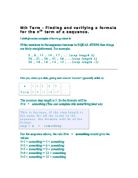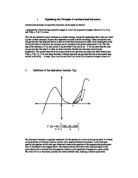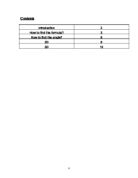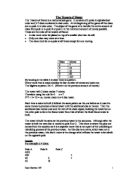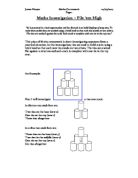Nth Term - Finding and verifying a formula for the nth term of a sequence.
Nth Term - Finding and verifying a formula for the nth term of a sequence. I shall give some examples of how to go about it. If the numbers in the sequence increase in EQUAL STEPS then things are fairly straightforward. For example: 5 , 8 , 11 , 14 , 17 , ... (step length 3) 26 , 31 , 36 , 41 , 46 , ...(step length 5) 20 , 18 , 16 , 14 , 12 , ...(step length -2) First you, draw up a table, giving each term its "counter" (generally called n) n 2 3 4 5 . . . Term 5 8 1 4 7 . . . The common step length is 3. So the formula will be 3×n + something (You can complete this something later on) This is because, if the step length is the same for all the terms in the sequence, the formula will be of the format: step × n + something For the sequence above, the rule 3×n + something would give the values 3×1 + something = 3 + something 3×2 + something = 6 + something 3×3 + something = 9 + something 3×4 + something = 12 + something 3×5 + something = 15 + something You then compare these values with the ones in the actual sequence - it should be obvious that the value of the something is +2 So the formula for the nth term is 3n + 2 That's Easy Enough! A second example.... n 2 3 4 5 . . . Term 26 31 36 41 46 . . . The common step length is 5. So the formula will be 5×n +
Is there maths behind M.C. Escher’s work? If so, what elements are there?
Is there maths behind M.C. Escher's work? If so, what elements are there? In this essay, before I start anything, I must first clarify that I deeply consider mathematics as a subject that has had a great influence on the artist and his masterpieces, therefore I already alarm you that throughout my essay I will talk about Escher's work and try to persuade you that there has been a considerable integration of the subject matter with his very artworks. In order to make you understand my objective, I have gathered some of his work, then selected a few, which I found had more mathematical elements, then with a decreased amount of drawings to work with, I would be able to study all components and show you that there has been a great influence of maths on him. I believe these images without the existence of any mathematical aspect would not be able to be fully accomplished. Elements like: symmetry (reflection also included), pattern/tessellation (repetition), transformation, crystallography, "impossible shapes", proportion and the 'Fibonacci Sequence' or the 'Golden Ratio'. Are suggested to be present in M.C. Escher's artworks, these I believe have been responsible to create the effect they create on the viewer, which is wonder and marvellous of the impressive art that cannot belong to the real world. Later on I will mention and try to explain these components, so that a random
About Triangular Square Numbers
About Triangular Square Numbers By August Pieres January 18th, 2003 I believe I have discovered an algorithm which generates an infinity of triangular squares. "Triangular squares" are triangular numbers which are also perfect squares. These are triangular numbers: 1,3,6,10,15,21,28,36,45,55,66,78,91,105,120,136,153,171,190,210,... Notice that 120=5! (and 6=3!) and that 1,3,21, and 55 are also Fibonacci numbers; one might call them "Fibonacci triangles." Are there any more Fibonacci triangles? These are the perfect squares: 1,4,9,16,25,36,49,64,81,100,121,144,169,196,225,256,289,324,361,400,... The only triangular squares listed so far are 1 and 36. Earlier today I thought that these were the only existing triangular squares, but I found out that there are more and quite possibly an infinity of them. I made a program on my programmable Texas Instruments TI-86 calculator. Here it is: PROGRAM:TRISQUAR -->N Lbl A N*(N+1)/2-->M If ?M==iPart?M Then Disp M End +N-->N Goto A I ran the simple program above and it found the following additional triangular squares: 1225, 41616, 1413721. Then I "played" with these new numbers -- with the help of the calculator -- trying to find patterns. To each triangular square corresponds a pair of parameters: s and t, such that a triangular square N is the sth perfect square and the tth triangular number, i.e. N=s2=Tt. So
Explaining the Principle of mathematical induction
Explaining the Principle of mathematical induction: Formally the principle of a proof by induction can be stated as follows: A proposition P (n) involving a positive integer n, is true for all positive integral values of n if, P (1), and P (k) ? P (k +1) is true. This can be explained using a staircase as a simple analogy. Image the proposition that a man can climb a given uniform staircase, to prove this statement we need to show two things. These are that the man can get onto the first step and that he is able to climb from one step to an other. Now relating this to the formal principle of induction, the staircase can be considered the general proposition P (n). The first step of the staircase is P (1), the second P (2), the third P (3), and so on. If we can show that the man can get onto the first step P (1) then we have ironically finished the first step of proving the proposition. The second step would be to prove that he can get from one step to an other formally put P (k) ? P (k +1). If we can show this than it follows that man can get from the first to the second step, second to the third,... n steps. Thus it can be said that P (n) is true for all positive integral values of n. 2 Definition of the derivative function f (x) The derivative function is a general expression for the gradient of a curve at any given point. It is based on the principle of limiting
A Square Investigation
A SQUARE INVESTIGATION Aim: The aim of this investigation is to find any rules, patterns of square numbers. Patterns/ rules will be discussed step by step below. Firstly a square number is a number multiplied by it. The name becomes apparent if one looks at a diagram of a square. e.g. 2^2 = 2*2= 4sq units; we say 4 is the square of 2. Hence a square number gives the area of a square. Method: the first step was to draw the table below. (Explain what each column means, draw a graph). X NUMBER X^2 SQUARE NO. OF TENS DIFFERENCE NO. OF UNITS 0 0 0 0 0 0 2 4 0 0 4 3 9 0 0 9 4 6 6 5 25 2 5 6 36 3 6 7 49 4 9 8 64 6 2 4 9 81 8 2 0 00 0 2 0 1 21 2 2 2 44 4 2 4 3 69 6 3 9 4 96 9 3 6 5 225 22 3 5 6 256 25 3 6 7 289 28 3 9 8 324 32 4 4 9 361 36 4 20 400 40 4 0 21 441 44 4 22 484 48 4 4 23 529 52 4 9 24 576 57 5 6 25 625 62 5 5 26 676 67 5 6 27 729 72 5 9 28 784 78 6 4 29 841 84 6 30 900 90 6 0 31 961 96 6 32 024 02 6 4 33 089 08 6 9 34 156 15 7 6 35 225 22 7 5 36 296 29 7 6 37 369 36 7 9 38 444 44 8 4 39 521 52 8 40 600 60 8 0 41 681 68 8 42 764 76 8 4 43 849 84 8 9 44 936 93 9 6 45 2025 202 9 5 46 2116 211 9 6 47 2209 220 9 9 48 2304 230 0 4 49
Borders and squares
Roxanne Dabiri BORDERS INTRODUCTION In this investigation I have been asked to find out how many squares would be needed to make up a certain pattern according to its sequence. The pattern is made up of squares surrounded by other square shapes to form a bigger cross-shape. * I will start of by drawing the squares (on the next page). The diagram will start with 1 square and each time I will add squares to each corner of the previous square. * I will count the number of squares in each diagram. After that I will put the numbers in a table. * Then I will see how many squares are added each time. Basically I will find the difference. * After finding the difference I will do a general rule to do find the equation. * Then I will test my rule to see if it is right or wrong. In this experiment I am going to need: * A calculator * A pencil * Variety of sources of information * A ruler PREDICTION I predict that we will find a constant difference between the number of cubes and from there we will be able to find the formula. I also predict that in this project we will get the formula (2n2) - 2n+1. Now I am going to draw the diagrams: 2 3 4 5 6 I have achieved the following information by drawing out the pattern and extending upon it. Seq. no 2 3 4 5 6 No. Of cubes 5 3 25 41 61 I am going to use this next method to see
Investigation to Find the number of diagonal of any 2 Dimensional or / and 3 Dimensional - A diagonal is a line drawn from one vertex (corner) of the shape to another
Contents Introduction 2 How to find the formula? 3 How to find the angle? 8 2D 9 3D 2 Introduction I will start my course-work by explaining off what the task is that I'm going to do. I have to find the number of diagonal of any 2Dimensional or/and 3Dimensional. A diagonal is a line drawn from one vertex (corner) of the shape to another, which is not an edge of the shape. Then, I will write some short sentences describing the task along with the diagram, which will be useful, including what I hope to find. To solve this problem, I will explain what I am going to do by starting with simple cases. For example, Triangle then Square then Pentagon and so on. What I think will happen and show all my calculation. In order to show the patterns, I could draw graphs to show it, including the results in the table. I must describe all the patterns and rules I find, explain each one clearly and show that my rules work by doing another examples of it. If I find the rules or the pattern, I will try explaining why they work. For example, If I discover that a number patterns goes up in 4s, my task may involve as 4-sided shape that causes this. In this experiment I am going to require the following: A calculator A pencil A pen Variety of sources of information Paper Ruler In this investigation I have been asked to find out how many squares would be needed to make up a
The Towers of Hanoi.
The Towers of Hanoi The Towers of Hanoi is a mathematical game. It consists of 3 poles in alphabetical order and 3-7 discs numbered in size order. At the beginning of the game all the discs are on pole A in size order. The object of the game is to transfer the entire amount of discs from pole A to pole B or pole C in the minimum amount of moves possible. These are the rules of the towers of Hanoi: * A disc must never be placed on top of a smaller disc than its self. * Only one disc may move at a time. * The discs must be on a pole at all times except for one moving Discs Moves 3 7 4 5 5 31 6 63 7 27 By looking at the table it is clear there is a pattern. Every move that is made doubles the last number of moves and adds one. The algebra equation: 2x+1. (Where x is the previous amount of moves) The tower with 3 discs makes 7 moves. Therefore using the rule 2x+1 x = 7 2*7 + 1= 15 = no. moves made in a 4 disc tower. Each time a tower is built it follows the same pattern as the one before as it uses the same moves to produce a Hanoi tower until the additional disc is moved. Then the additional disc moves once and the rest of the discs repeat, building the tower but on the other pole to form the Hanoi tower from that of which the final Hanoi tower is built. The tower is built the same as the previous tower in the sequence. Although after the
Maths Coursework: Consecutive Numbers
MARTIN GALLAGHER Maths Coursework: Consecutive Numbers Introduction In this coursework I am trying to find a common pattern in consecutive numbers, and then solve the pattern with algebra. Problem 1: Write down three consecutive numbers. Square the middle number; multiply the first number by the third. Compare your answers, what do you notice? Problem 2: Write down two consecutive numbers. Square both of the numbers and find the difference between the two squares, what do you notice? Problem 3: Write down five consecutive numbers. Square the middle number; multiply the first number by the fifth. Compare your answers, what do you notice? Problem 4: Write down three consecutive numbers but this time with a gap between them, like this: 1, 3, 5. Square the middle number; multiply the first number by the third. Compare your answers, what do you notice? Problem 1 Chosen consecutive numbers Middle number squared First number multiplied by the last. Difference 9, 10, 11 5, 6, 7 7, 8, 9 0, 11, 12 8, 19, 20 00 36 64 21 361 99 35 63 20 360 In the above table you can see that each set of consecutive numbers created shows the "Middle number squared" is +1 more than the "First number multiplied by the last". From this pattern I will solve it by using algebra. The equation for the "Chosen consecutive numbers" is: n, n + 1, n + 2. Formula n, n + 1, n + 2 =
Maths Investigation - Pile 'em High
Maths Investigation - Pile 'em High "Jo has started in a local supermarket and her first job is to build displays of soup tins. To make them stable they are stacked using a brick bond so that each tins stands on two others. The tins are stacked against the wall. Each stack is complete with one tin in the top row." This piece of Maths coursework is about investigating sequences from a practical situation. In this investigation, tins are used to build stacks using a brick bond so that each new tin stands on two others. The tins are stacked flat against a structure and each stack is complete with one tin in the top row. An Example: First I will investigate a two row stack. In this two row stack there are: Two tins on the base (row 2) One tin on the top (row 1) Three tins altogether In a three row stack there are: Three tins on the base (row 3) Two tins in the middle (row 2) One tin on the top (row 1) Six tins altogether An early pattern that I can see is that whatever the row number (counting down from row 1 at the top) there are that many tins in the row e.g. row 3 - 3 tins. It appears to me that there is some kind of pattern forming with the total number of tins in each built up stacks. (See table) Number of Stacks The Amount of Tins 2 3 3 6 4 0 5 ? I predict that for five stacks, the amount of tins needed will be fifteen based on other stacks e.g.


